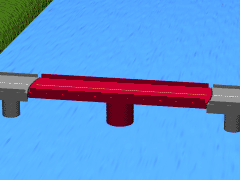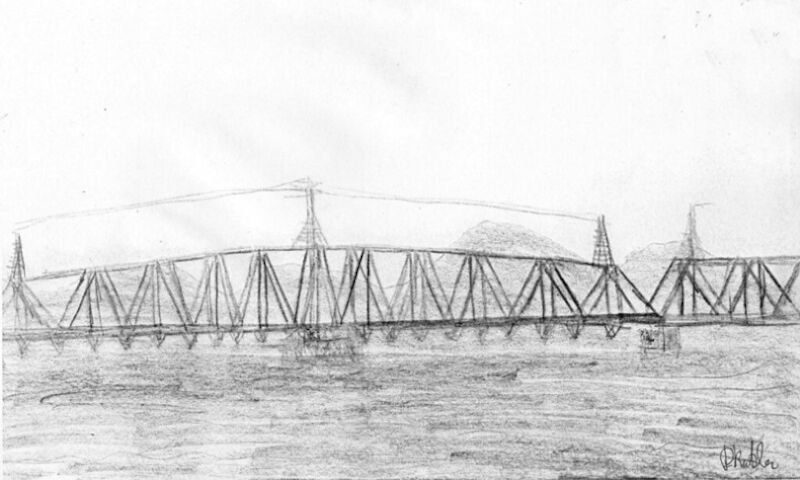June 18, 1888 Train Wreck.
A jrd stat on 1/11/17.
Music: "Working On The Railroad."

|
June 18, 1888 Train Wreck. A jrd stat on 1/11/17. Music: "Working On The Railroad." 
|
 In the normal bridge position the movable swing span is lined up with the railway, or roadway if on a highway bridge and locked. Normal traffic is across the bridge. When a water vessel needs to pass the bridge, the swing part of the bridge is rotated about an axis to lined up horizontal to the river allowing the water vessel to pass. |
Rockport Train Wreck. Most of us have heard the expression, "Truth is stranger than fiction" and no doubt, it is mostly true. In practically any event, especially an event that would be world wide news, the actual event, in most cases, is stranger and/or more gory than the tales that follow in the years to come. The railroad bridge at Rockport has seen many events and some events were quite gruesome. I was a teenager when the hobo was killed by a train while crossing the trestle that connects to the bridge on the west side of the river and I have written about the event in the section called "The Hobo". At the time it happened, I was not aware of the event where the young girl fell on to the concrete structure of the bridge, but have a page on it called "The Young Girl". Another tragedy of the bridge occurred before the current bridge was built and when the bridge was a "Swing Bridge". This event was an occurrence of a train falling from the bridge into the river. I have a page on it called "The Lost Train". These three tragedies, as well as many more, have been told and retold to the youngsters at Rockport and other near towns by the elders to stress on the youngsters that the bridge is a dangerous place to be and their advice would be to stay away from the bridge. Avoiding the bridge because of a tragedy was a moot point to most of us, but you can believe that anytime we were on the bridge, the danger was in out heads and we were just a little more careful. "The Lost Train", as mentioned above, is a "Railroad Page" on this web site about a train plunging into the river in the later part of the nineteenth century. The page was written from memory taken from the tales told to me by my parents, grandparents, and others. It is about a train falling into the Green River. Some research on the subject has led me to want to write another page about the train wreck, not from my memory, but from information obtained from the Hartford Herald. I have titled it "The Lost Train II". Following is my understanding of the train wreck from the June 20th, 1888 edition of the Hartford Herald. THE HARTFORD HERALD-June 20, 1888. AN AWFUL PLUNGE. A Train Goes Though the Railroad Bridge at Rockport Into Green River Below -- Description of the Horrible Scene. Rockport, Ky., June 18, 1888. It was a nice Saturday, summer afternoon, a little before three, when an Illinois Central Railroad freight train, Old Number 16, left Central City heading East to Louisville. The train consisted of an engine and a tender, two loaded coal cars, and a caboose. Two men were in the steam engine and a total of five men were in the caboose. Old Number 16 made a short stop at Nelson Station and then proceeded toward Rockport. Fifteen minutes or so later, the train gave a loud customary toot as it was approaching the long trestle, before entering the bridge over Green River at Rockport. The lone bridge watchman on the bridge, waiting for the train to pass, eased closer to the bridge edge to give the train plenty of room to pass. At precisely nine minutes before four o'clock, the East bound train pulled upon the bridge to cross the Green River as it had so many times before. This time would be so very much different. Just before the train reached the middle pier, while the train was well on the first span, suddenly and without any warning one hundred and eighty feet of the bridge gave way and plunged into the river with a terrible crash. The train, wrecked timbers, iron, and the eight involved men were hurled into the river area some forty feet below. The train, except for the caboose, was now in the river. The caboose fell on the bank between the river and the first bank pier. Language could not describe this horrible and distressful scene. Tons and tons of timbers and iron along with two of the men were now in the river. You must see it, to fully realize such a blood-curdling disaster, was a point made for the newspaper. The fearful noise electrified the town, although just such a calamity was not altogether unexpected to many, as the bridge was believed to have been unsafe for months and months. That a single one even lived a minute afterward is miraculous. A hundred or so willing hands were soon at work digging mangled bodies from the wreck, and it was not long till the hotel was turned into a hospital of groaning men writhing in agony. Two of the men were found in the water feebly clinging to floating timbers, and five inside the crushed caboose were more dead than alive. That is seven of the eight men involved. The eight man was in the engine and drowned as the engine sank to the bottom of the river. The following is a brief list of casualties: A colored brakeman named Coleman from New Albany, Ind., was in the cab with the fireman, and sank with the engine to the bottom of the river and was drowned. His body has not been recovered. Indeed nobody seems to have tried to recover it. He had just counted his money, $175, and was in the act of returning it to his pocket, when the crash occurred. The fireman, Henry Friz, Central City, who was running the engine at the time, held to the throttle when the reaction washed him out of the cab, and he rose to the surface when he swam to floating timber, and held on till taken out. Strange to say, his wounds are perhaps less serious than any in the wreck. He got off with a strained back, cut on right knee, and lacerated finger. He certainly held on to the throttle, however, as long as there was any earthly use of hanging. Tom Fogle, bridge watchman, who had flagged the train over, and was waiting for it to pass, fell with the immense pile of debris into the river, and was taken out more dead than alive. His wounds are very serious as compression of the spinal cord is indicated besides a severely strained back and many bruises. Engineer Phil Carroll, Louisville, was found in the caboose, and was carried out with a compound fracture of left leg, dislocated wrist, deep scalp wound and strained back, besides many bruises. The chances are that he will never recover, as amputation will be necessary, and he has already borne more than most men could bear. John Compton, conductor, Louisville, was chopped out of the collapsed caboose and carried out. He is perhaps fatally injured. His face was bruised to a jelly, his thigh fractured, hips crushed, left ankle dislocated, back strained and injured internally. John Love, yard master, Central City, who was in the caboose, was carried out almost dead. He was seriously hurt, and may not recover, though there are strong hopes this morning. His right wrist was fractured, several fearful scalp wounds, and back strained. His suffering has been most acute and distressing, but he is it man of powerful constitution, and I hope will soon recover. S. F. Bennett, pump repairer, of this place, next to the fireman, was most fortunate. He got off with a scalp wound, which addled him for awhile, contusion on one leg and several severe bruises. The colored brakeman, named Austin, (of) McHenry, was found to have a deep and ugly puncture in the back, which though very painful, is not supposed to be dangerous. Doctors Jackson and Maddox went promptly to work and stayed with their patients like men of skill and sympathy. Every assistance possible was rendered by our kind and anxious citizens. A special left Louisville as soon as they got the wires, which were torn down, to work, bringing several of the higher officials, but no physicians except Dr. Slayton from Leitchfield. The latter's coolness and skill is a credit to his profession. Dr. Munnell, of Paducah, Chief Surgeon, arrived at 6 o'clock Sunday morning. Doctors Bohanan and Slayton, Greenville; Rhorer and Warren, Central City; and Smith, of McHenry, were also on hand. Scores and scores of people from all parts of the county visited the wreck during Sunday. One hundred men are working night and day clearing away the wreck, and the work of rebuilding is progressing rapidly. Piles will be driven in the river upon which false work will be built, and no doubt, trains will be passing over within a week. In the mean time, regular transfers will be made across at the ferry, connecting with trains at Pain Town. Information for this article was taken from the June 20, 1888 edition of the Hartford Herald. The description of the casualties have been mostly left intact. Thanks for looking. See you........ jrd |
 Artist conception of the old Rockport Swing Bridge, circa 1870-1930. Artist unknown. |
| Thanks for looking. |